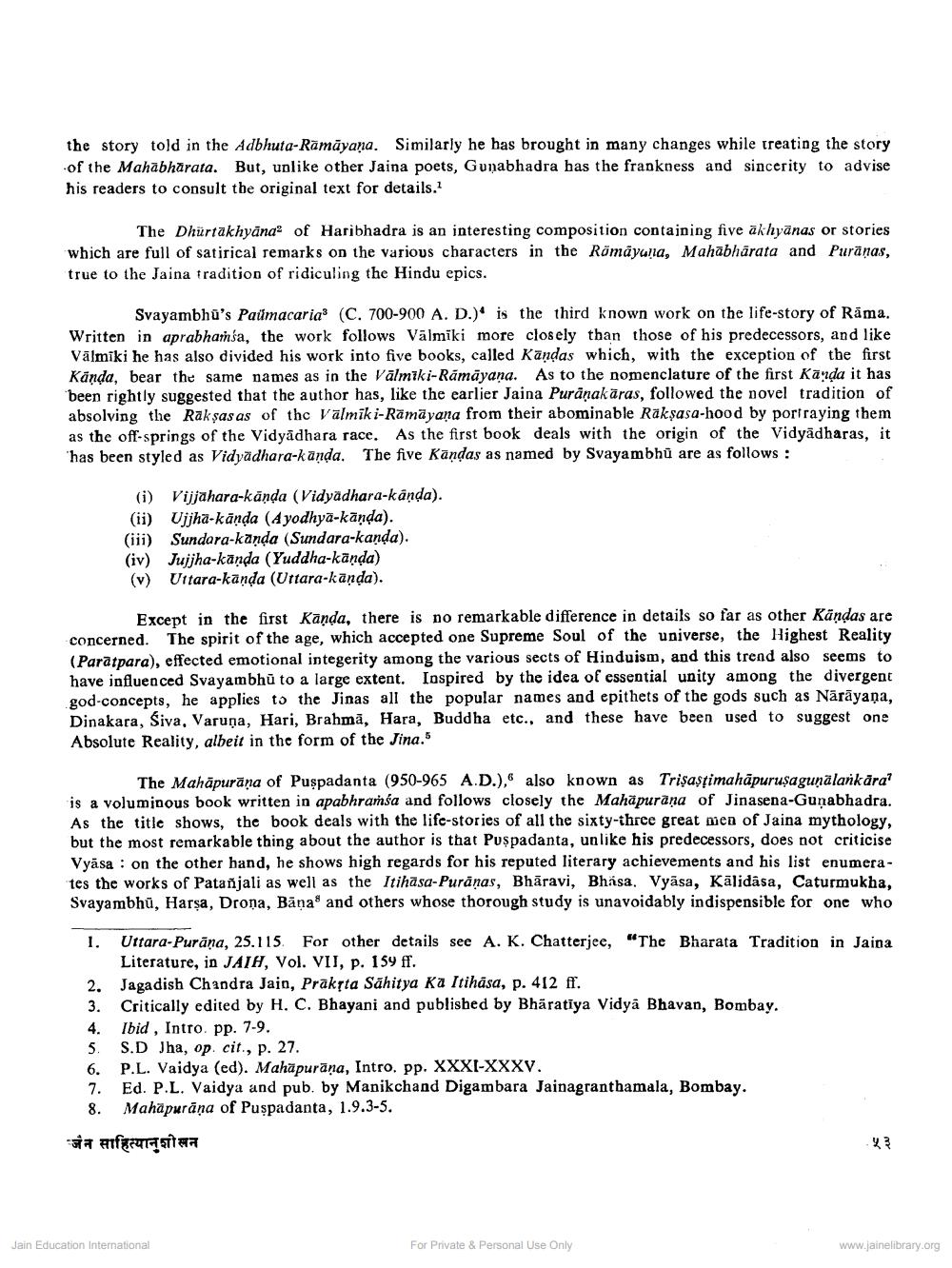________________
the story told in the Adbhuta-Rāmāyana. Similarly he has brought in many changes while treating the story of the Mahabharata. But, unlike other Jaina poets, Gunabhadra has the frankness and sincerity to advise his readers to consult the original text for details.
The Dhürtākhyāna” of Haribhadra is an interesting composition containing five ākhyānas or stories which are full of satirical remarks on the various characters in the Römāyana, Mahābhārata and Purānas, true to the Jaina tradition of ridiculing the Hindu epics.
Svayambhu's Paümacaria (C. 700-900 A. D.)' is the third known work on the life-story of Rama. Written in aprabhamsa, the work follows Vālmīki more closely than those of his predecessors, and like Vālmīki he has also divided his work into five books, called Kandas which, with the exception of the first Kānda, bear the same names as in the Vālmiki-Rāmāyana. As to the nomenclature of the first Kānda it has been rightly suggested that the author has, like the earlier Jaina Puránakaras, followed the novel tradition of absolving the Raksas as of the Valmik i-Rāmāyana from their abominable Raksasa-hood by portraying them as the off-springs of the Vidyadhara race. As the first book deals with the origin of the Vidyadharas, it has been styled as Vidyadhara-kanda. The five Kandas as named by Svayambhú are as follows:
(i) Vijjahara-kānda (Vidyadhara-kända). (ii) Ujjha-kānda (Ayodhya-kända). (iii) Sundara-kanda (Sundara-kanda). (iv) Jujjha-kända (Yuddha-kanda) (v) Uttara-kanda (Uttara-kanda).
Except in the first Kanda, there is no remarkable difference in details so far as other Kāndas are concerned. The spirit of the age, which accepted one Supreme Soul of the universe, the Highest Reality (Paratpara), effected emotional integerity among the various sects of Hinduism, and this trend also seems to have influenced Svayambhū to a large extent. Iospired by the idea of essential unity among the divergent god-concepts, he applies to the Jinas all the popular names and epithets of the gods such as Nārāyaṇa, Dinakara, Siva, Varuņa, Hari, Brahma, Hara, Buddha etc., and these have been used to suggest one Absolute Reality, albeit in the form of the Jina.
The Mahāpurāņa of Puşpadanta (950-965 A.D.), also known as Trişasțimahāpuruṣagunälankāra? is a voluminous book written in apabhraíśa and follows closely the Mahapurana of Jinasena-Guņabhadra. As the title shows, the book deals with the life-stories of all the sixty-three great men of Jaina mythology, but the most remarkable thing about the author is that Puspadanta, unlike his predecessors, does not criticise Vyasa : on the other hand, he shows high regards for his reputed literary achievements and his list enumerates the works of Patañjali as well as the Itihasa-Purānas, Bhāravi, Bhasa. Vyasa, Kalidasa, Caturmukha, Svayambhū. Harsa, Drona, Bana' and others whose thorough study is unavoidably indispensible for one who
1. Uttara-Purāna, 25.115 For other details see A. K. Chatterjee, "The Bharata Tradition in Jaina
Literature, in JATH, Vol. VII, p. 159 ff. Jagadish Chandra Jain, Praksta Sahitya Ka Itihasa, p. 412 ff. Critically edited by H. C. Bhayani and published by Bharatiya Vidya Bhavan, Bombay.
Ibid , Intro. pp. 7-9. 5. S.D Jha, op. cit., p. 27. 6. P.L. Vaidya (ed). Mahāpurāņa, Intro. pp. XXXI-XXXV. 7. Ed. P.L. Vaidya and pub. by Manikchand Digambara Jainagranthamala, Bombay.
8. Mahapurāņa of Puşpadanta, 1.9.3-5. जैन साहित्यानुशीलन
Jain Education International
For Private & Personal Use Only
www.jainelibrary.org




